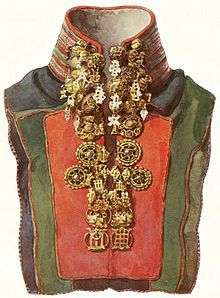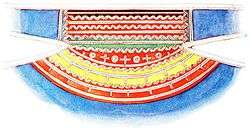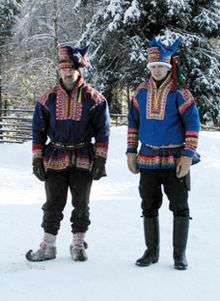Gákti


Gákti is the Northern Sámi word for a piece of traditional clothing worn by the Sámi in northern areas of Norway, Sweden, Finland and the Kola Peninsula in Russia. The gákti is worn both in ceremonial contexts and while working, particularly when herding reindeer. The traditional Sami outfit is characterized by a dominant color adorned with bands of contrasting colours, plaits, pewter embroidery, tin art, and often a high collar. In the Norwegian language the garment is called a 'kofte', and in Swedish it is called 'kolt'.
Characteristics
The colours, patterns and decorations of the costume can signify a person's marital status and geographical origin. There are different gákti for women and men; men's gáktis are shorter at the hem than women's. Traditionally the gákti was made from reindeer skin, but in modern times, wool, cotton or silk are more common. The gákti can be worn with a belt (pleated, quilted or with silver buttons), silver jewellery, traditional leather footwear and a silk scarf. Traditionally, if the buttons on the belt are square, it shows the wearer is married. If they are round, the person is unmarried. If a married couple divorce, and the ex-husband still continues to use the Sami costume made by his ex-wife, he states by this that he wants her back.
See also
References
- Fra hverdagsplagg til kulturelt kjennetegn Norwegian Digital Learning Arena / Norwegian News Agency (in Norwegian)
![]()
